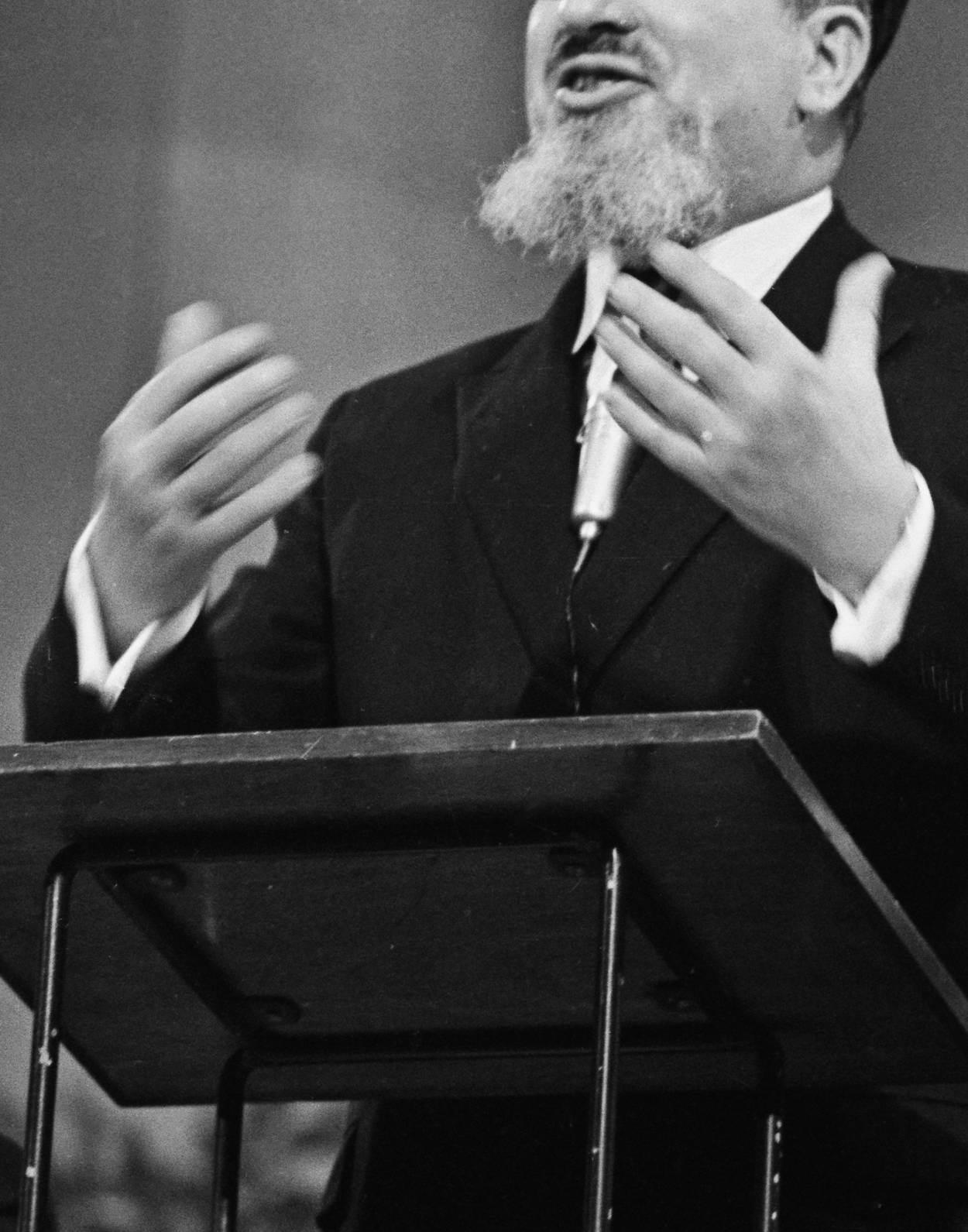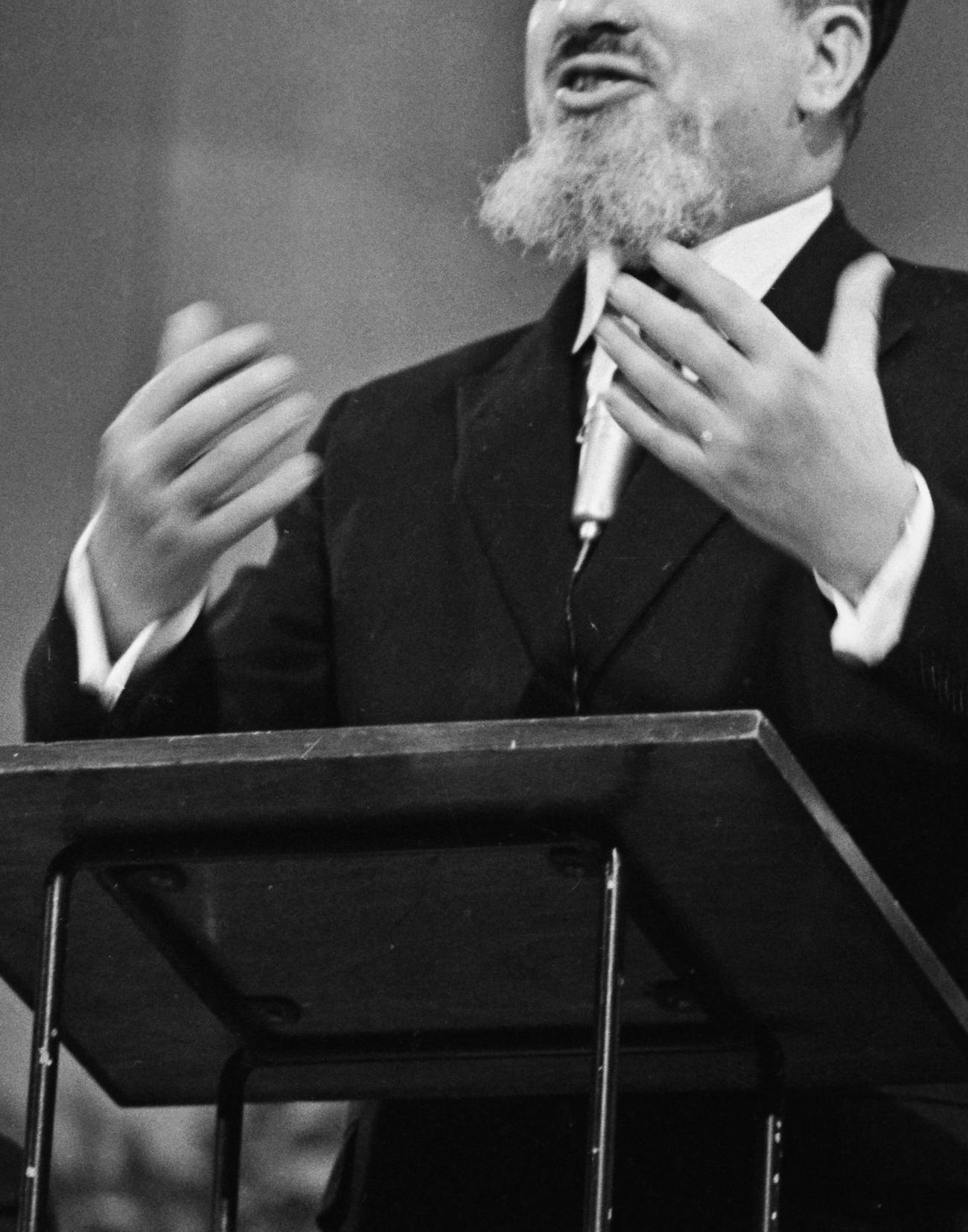Figures of Speech
The rise and fall of rabbinical sermons




My parents—my father, especially—loved a good sermon, though what qualified as one was up for grabs, the subject of much discussion over lunch on Shabbat. Had it to do with topicality or scholarship? Brevity or length? The frequency of references to The New York Times or to highfalutin and somewhat arcane literary figures such as Anatole France? (Anatole who?!)
It was hard to tell. As a little kid, all I knew, or could make out, was that there was something about the sermon that prompted animated conversations between my parents and the adult guests, if there were any, at our table. It was almost as if taking the measure of a sermon constituted a Shabbat ritual all its own.
At the time, the appeal of this 20- or 30-minute exercise eluded me; it eludes me still. I understand and appreciate how much effort goes into crafting a sermon and just how meaningful the practice can be. Many members of the contemporary clergy relish the weekly opportunity to hold forth, to “articulate matters which [congregants] have on their mind,” as my dear friend Rabbi Peter Schweitzer would have it. I get it, but, as far as I’m concerned, the sermon’s allure falls on deaf ears. I’d much rather sing.
In this, I’m not alone. The status of the sermon has markedly weakened over time. Once the cynosure of the congregation, even the high point of the Sabbath service, its prominence is no longer assured. While it has not gone the way of shnuddering, the public auction of communal honors, a formal address is far less vital to the proceedings, let alone a measure of the rabbi’s chops, than it had once been.
In the United States of the late 19th and 20th centuries, congregations highly prized rabbis who excelled at being “pulpit orators.” Where today we place a premium on pastoral rather than rhetorical skills, back in the day the rabbi’s “pulpit ministrations” reigned supreme, the mark of a decidedly modern synagogue rather than one fueled by the “momentum of the past.”
Even the architecture of the modern sanctuary was purposefully designed to give preaching an added boost. The systematic use of acoustic tiles, front-facing pews, elevated pulpits, and later still, mechanized sound systems and microphones ensured that the rabbi’s words would make their way, unimpeded and clear as a bell, from his mouth to his congregants’ ears.
He had much to say, after all, weighing in on topics that ranged from “Ten Commandments for Parents” to “The Courage to be a Jew,” and from “Woman’s Influence” to “Patriotism and the Jews.” Both preacher and auditor set much store by the sermon, seeing in it an instrument to inspire, comfort, educate, and encourage, “to impart Jewish knowledge” and to “stimulate Jewish faith.”
A tall order, whose mighty expectations were often hard to satisfy, a successful sermon was one in which substance, style, acoustics, and, most especially, a very good command of English worked in sync. As far back as the 1870s, American Jewish congregants insisted on an English-speaking rabbi who could “articulate the vernacular of our beloved country as trippingly from the tongue” as any actor. As much a function of modernization as of theatrics, an English-speaking rabbi betokened the future; the absence of one pointed to the past. A clergyman who insisted on preaching in German or in Yiddish was said to be a “century behind and thousands of miles distant from his flock.”
Even so, traditional elements within the American Jewish community did not initially warm to either the notion of an English-speaking rabbi or to a regularly scheduled sermon in lieu of an occasional drash. By their lights, both resided far outside the pale of authentic Judaism. Digging in their heels, America’s Orthodox Jews stood firm in their opposition, insisting that the road to Reform, or worse still, out the door, was paved with the words of a sermon.
“Cold figures” compiled in the 1910s bore out the extent of communal resistance. A statistical study of synagogue life in New York City, much of it sustained by East European immigrants, revealed that a whopping 4 out of 5 urban houses of worship did not offer English-language sermons. Clearly, the study concluded with a gentle rebuke, they had not “reckon[ed] with the environment.”
Little by little, though, amid growing affluence and acculturation, many Orthodox Jews in prewar America relaxed their opposition to the sermon. They came to see the rabbinic display of English verbal prowess as a boon rather than a blemish, a drawing card rather than a symbol of declension. As one of American Orthodox Jewry’s greatest orators, Joseph H. Lookstein, put it, “in the modern synagogue, it is the sermons delivered by the rabbi that afford a means of close contact with the congregation.”
Though it took a number of years before the sermon became a perquisite of the modern synagogue, it didn’t take long for congregants to become critics. There was no stopping them from caviling about this, that, and the other thing: The rabbi went on for too long or spoke too briefly; his demeanor in the pulpit was too hoity-toity or excessively chummy; the content of his remarks flew over their heads or underestimated their intelligence; his insights were too scriptural or not scriptural enough, too dense or too thin, too hard-hitting or too vacuous.
“Words, words, words,” was how one disgruntled American Jew described his rabbi’s verbose sermons in 1904. “Instead of putting me into the mood that a sermon should, they irritate me.” Another took exception to his rabbi’s repertoire of mannerisms, counseling him to refrain from wetting his lips while speaking or throwing back his head in the manner of a Methodist preacher, lest these gestures get in the way of his substance.
To ensure the congregation’s goodwill and sustain its “powers of endurance,” as a hard-pressed preacher wryly put it, aspiring rabbis were trained in homiletics, the art of preaching. “Thank God!” remarked a member of the laity in 1878 upon learning that Hebrew Union College had introduced homiletics into its curriculum. Since then, virtually every American rabbinical seminary across the denominational spectrum has instructed its candidates for the clergy in what to say and how to say it, when to “learn there’s a time to preach, but also a time to stop preaching … And how hard is this lesson to learn!” said one frustrated practitioner skilled in “public persuasion.”
For all the training rabbis received, once on their own and in the field, the need for a helping hand to navigate the thicket of congregational critique gave rise to a new genre of American Jewish literature: guidebooks on what made for an effective sermon.
There were different ways to go about it. In some instances, rabbis whose public addresses were well received took to publishing them, hoping they might serve as a model for their more challenged colleagues. Israel H. Levinthal’s 1928 volume, Steering or Drifting: Which?: Sermons and Discourses, was a case in point. The beloved rabbi of the Brooklyn Jewish Center whose pulpit he occupied for over 60 years, from 1919 to 1982, Levinthal made sure to note how those in the pews took to his sermons, subsequently jotting down on the margins of his texts whether it was “hard to get attention,” or “excellent.”
At other moments, sermonic guidebooks were expressly didactic: more how-to than show-and-tell. Replete with useful asides, helpful pointers, and “sound advice,” Solomon Freehof’s Modern Jewish Preaching (1941) took that approach. Acknowledging that the role of the modern Jewish preacher “bristles with difficulties,” the longstanding rabbi of Pittsburgh’s Temple Rodef Shalom, a man widely celebrated as much for his eloquence and “beautifully crafted phrasing” as for his scholarship, sought to reassure his younger colleagues that with the right amount of preparation and sensitivity to the “specific moods and tastes” of their congregants, they, too, could come up with a sermon that “did good.”
Today’s rabbis, like their predecessors, also look for ways to connect with their congregants. In their mutual search for a more intimate, less performative encounter, they have rearranged the furniture of the sanctuary as well as the structure of the service, often substituting text study, or a d’var Torah for the sermon. Literally meaning a “word” of wisdom rather than a torrent—a succinct presentation, designed to frame the biblical text the congregation is about to read—this form of exchange has become more and more commonplace. The sermon, in turn, is increasingly associated with the High Holidays, an annual occasion rather than a weekly occurrence.
Some of us might miss hearing a sermon every Shabbat while others are content with its limited appearance. Everyone can agree that, in the end, its role in modern Jewish life says as much about us—our needs, our values—as it does about the Torah portion of the week or Anatole France.
Jenna Weissman Joselit, the Charles E. Smith Professor of Judaic Studies & Professor of History at the George Washington University, is currently at work on a biography of Mordecai M. Kaplan.